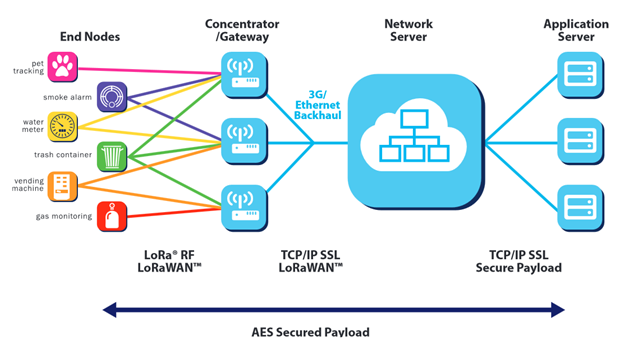
LoRaWAN is a radio telecommunication protocol allowing low speed and long range communication for connected objects. It transmits in France on the 868MHz frequency band. The radio signal is emitted over a wide spectral range, to limit the risk of interference with parasite signals. This modulation technique, Chirp Spread Spectrum (CSS) is used for space and military communications.
Unlike traditional mobile networks, such as 4G or 5G, which can carry large amounts of information, LoRa allows the transport of information between 0.3 and 50 kbits per second: the network rate adapts to each object and thus respects the bandwidth.
This information can be transmitted over longer distances than on traditional telecom networks. An object connected in LoRa can send a message to a terminal located at a distance of about 1 kilometer in urban areas and 20 kilometers in open environments. More than 167 million connected objects worldwide were communicating in December 2020 using LoRaWAN.




LoRaWAN is a communication protocol based on LoRa modulation. It defines the system architecture of the network. This is important because it has a decisive influence on battery life, network load capacity, quality of service, security, and the variety of applications served by the network.
In a LoRaWAN network, the nodes (devices/products) are not associated with a single base station. The data they transmit is relayed by multiple stations. Each station transmits the information received from the node to the management server connected to the Internet. The intelligence and complexity are deported to this server, which manages the redundancy of information, integrity verification, confirmation of reception, adaptation of the transmission rate and power, etc.
PRODUCT Classes
Products have different needs. In order to optimize each application, LoRaWAN offers several classes of devices. All classes are Bidirectional.
The choice of the class used is a compromise between battery life and communication latency.
- CLASS A
- CLASS B
- CLASS C
Class A terminals allow two-way communication by opening two short reception windows after each transmission.
This class reaches the lowest power consumption. However, all communications to the device must wait for the device to transmit information.
Class B terminals are similar to Class A terminals, with the added functionality of scheduling reception windows based on time information distributed by the network infrastructure.
Class C terminals follow the Class A model over continuous listening to one channel. This allows devices with sufficient power to listen continuously outside the transmission windows.
This class offers the best latency in terms of bidirectional communication. However, it will have a high power consumption because it is constantly listening. It is recommended to power products using class C.
Become an expert with this unique IoT LoRa training "LoRaWAN & LoRa for Internet of Things"
The University of Savoie Mont Blanc also offers this LoRa-LoRaWAN training course to handle LoRaWAN objects and Gateways. You will receive an educational kit with Device and Gateway that you will keep at the end of the training.

SÉCURITÉ
Le cryptage AES est utilisé avec un échange de clés basé sur un identifiant IEEE EUI6.
PORTÉE RADIO
Communication longue distance
Résistance aux interférences
LOW POWER
Durée de vie des batteries
Faible consommation







 Mobile application
Mobile application












